Analysis of Teamwork and Leadership in Nursing Practice
VerifiedAdded on 2023/01/18
|7
|1637
|46
Report
AI Summary
This report provides a comprehensive analysis of teamwork and leadership in nursing, emphasizing the evolution of patient care from isolated practices to collaborative healthcare teams. It explores the different types of healthcare teams, including core, coordinating, ancillary, and contingency teams, and the stages of team development. The report highlights the values and principles of effective teamwork, such as discipline, creativity, and humility, and their importance in acute care tertiary hospitals. It details the benefits of effective teamwork for organizations, teams, patients, and individual team members, including reduced costs, improved patient satisfaction, and enhanced job satisfaction. Furthermore, the report addresses the challenges of effective teamwork, such as resolving disagreements, team instability, and individualistic tendencies, and concludes with recommendations for fostering a culture of teamwork in healthcare settings to improve patient outcomes and the overall quality of care. The report references relevant studies and articles to support its findings and recommendations.

TEAMWORK AND LEADERSHIP IN NURSING 1
Teamwork and leadership in nursing
Name:
Institution:
Tutor:
Date:
Teamwork and leadership in nursing
Name:
Institution:
Tutor:
Date:
Paraphrase This Document
Need a fresh take? Get an instant paraphrase of this document with our AI Paraphraser
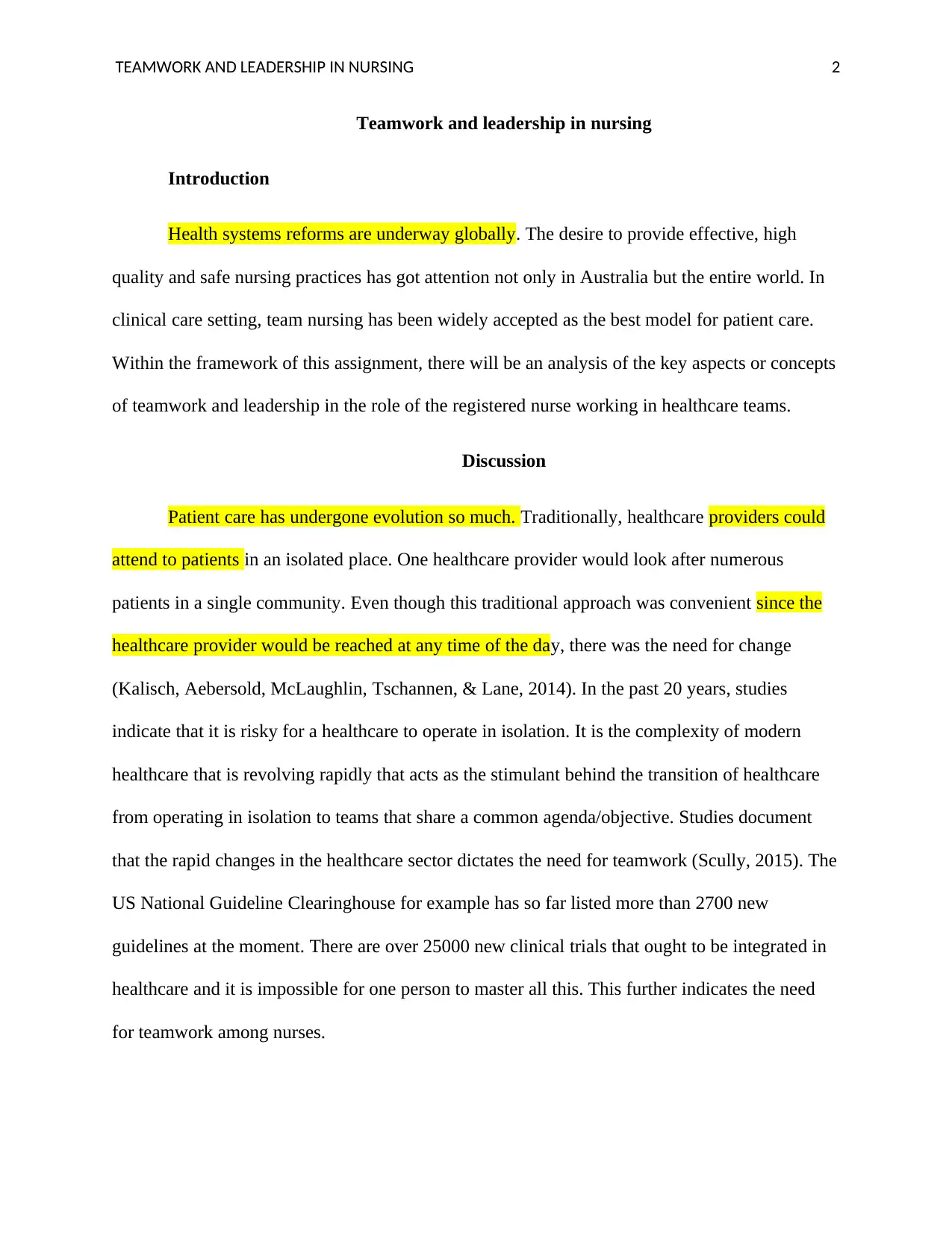
TEAMWORK AND LEADERSHIP IN NURSING 2
Teamwork and leadership in nursing
Introduction
Health systems reforms are underway globally. The desire to provide effective, high
quality and safe nursing practices has got attention not only in Australia but the entire world. In
clinical care setting, team nursing has been widely accepted as the best model for patient care.
Within the framework of this assignment, there will be an analysis of the key aspects or concepts
of teamwork and leadership in the role of the registered nurse working in healthcare teams.
Discussion
Patient care has undergone evolution so much. Traditionally, healthcare providers could
attend to patients in an isolated place. One healthcare provider would look after numerous
patients in a single community. Even though this traditional approach was convenient since the
healthcare provider would be reached at any time of the day, there was the need for change
(Kalisch, Aebersold, McLaughlin, Tschannen, & Lane, 2014). In the past 20 years, studies
indicate that it is risky for a healthcare to operate in isolation. It is the complexity of modern
healthcare that is revolving rapidly that acts as the stimulant behind the transition of healthcare
from operating in isolation to teams that share a common agenda/objective. Studies document
that the rapid changes in the healthcare sector dictates the need for teamwork (Scully, 2015). The
US National Guideline Clearinghouse for example has so far listed more than 2700 new
guidelines at the moment. There are over 25000 new clinical trials that ought to be integrated in
healthcare and it is impossible for one person to master all this. This further indicates the need
for teamwork among nurses.
Teamwork and leadership in nursing
Introduction
Health systems reforms are underway globally. The desire to provide effective, high
quality and safe nursing practices has got attention not only in Australia but the entire world. In
clinical care setting, team nursing has been widely accepted as the best model for patient care.
Within the framework of this assignment, there will be an analysis of the key aspects or concepts
of teamwork and leadership in the role of the registered nurse working in healthcare teams.
Discussion
Patient care has undergone evolution so much. Traditionally, healthcare providers could
attend to patients in an isolated place. One healthcare provider would look after numerous
patients in a single community. Even though this traditional approach was convenient since the
healthcare provider would be reached at any time of the day, there was the need for change
(Kalisch, Aebersold, McLaughlin, Tschannen, & Lane, 2014). In the past 20 years, studies
indicate that it is risky for a healthcare to operate in isolation. It is the complexity of modern
healthcare that is revolving rapidly that acts as the stimulant behind the transition of healthcare
from operating in isolation to teams that share a common agenda/objective. Studies document
that the rapid changes in the healthcare sector dictates the need for teamwork (Scully, 2015). The
US National Guideline Clearinghouse for example has so far listed more than 2700 new
guidelines at the moment. There are over 25000 new clinical trials that ought to be integrated in
healthcare and it is impossible for one person to master all this. This further indicates the need
for teamwork among nurses.
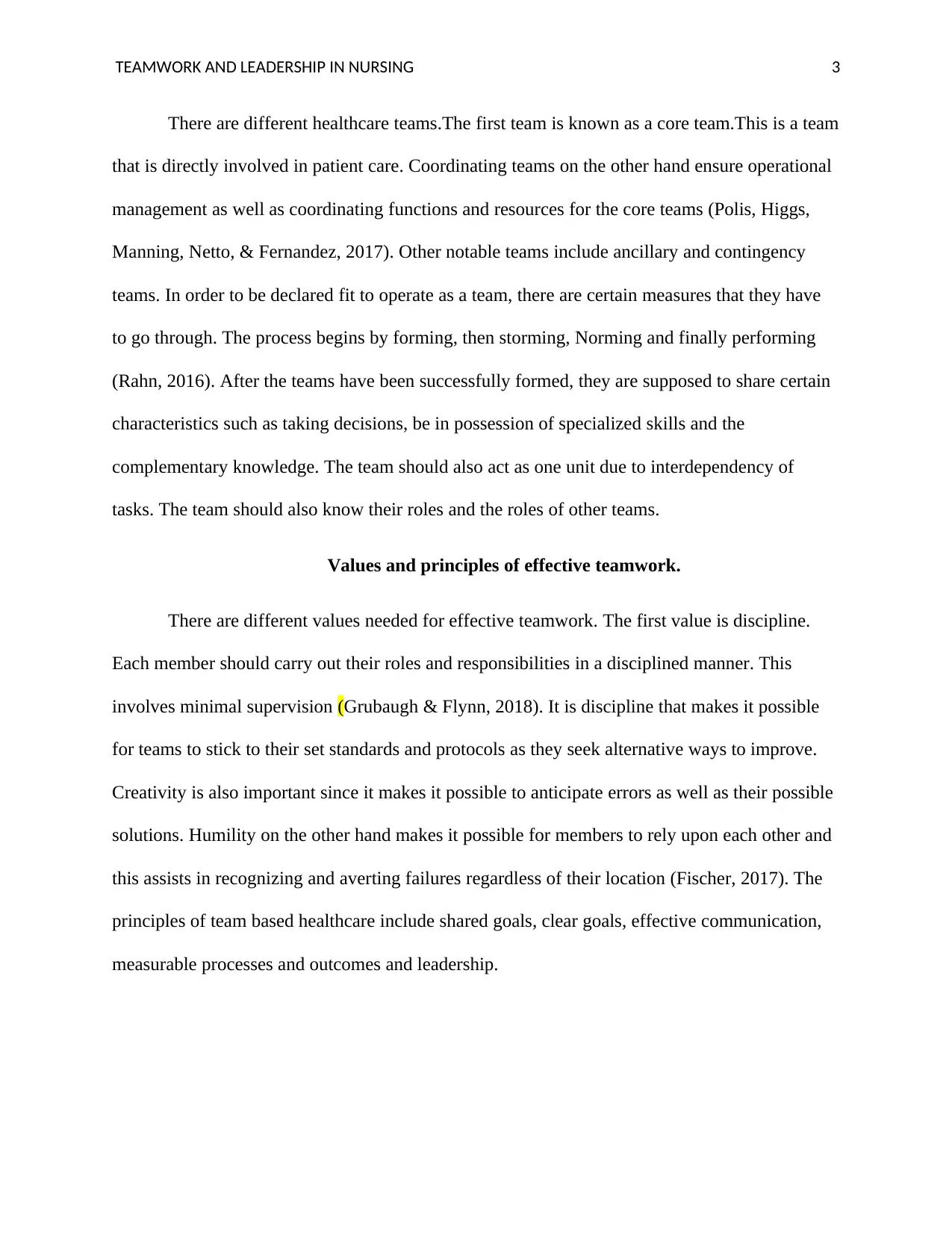
TEAMWORK AND LEADERSHIP IN NURSING 3
There are different healthcare teams.The first team is known as a core team.This is a team
that is directly involved in patient care. Coordinating teams on the other hand ensure operational
management as well as coordinating functions and resources for the core teams (Polis, Higgs,
Manning, Netto, & Fernandez, 2017). Other notable teams include ancillary and contingency
teams. In order to be declared fit to operate as a team, there are certain measures that they have
to go through. The process begins by forming, then storming, Norming and finally performing
(Rahn, 2016). After the teams have been successfully formed, they are supposed to share certain
characteristics such as taking decisions, be in possession of specialized skills and the
complementary knowledge. The team should also act as one unit due to interdependency of
tasks. The team should also know their roles and the roles of other teams.
Values and principles of effective teamwork.
There are different values needed for effective teamwork. The first value is discipline.
Each member should carry out their roles and responsibilities in a disciplined manner. This
involves minimal supervision (Grubaugh & Flynn, 2018). It is discipline that makes it possible
for teams to stick to their set standards and protocols as they seek alternative ways to improve.
Creativity is also important since it makes it possible to anticipate errors as well as their possible
solutions. Humility on the other hand makes it possible for members to rely upon each other and
this assists in recognizing and averting failures regardless of their location (Fischer, 2017). The
principles of team based healthcare include shared goals, clear goals, effective communication,
measurable processes and outcomes and leadership.
There are different healthcare teams.The first team is known as a core team.This is a team
that is directly involved in patient care. Coordinating teams on the other hand ensure operational
management as well as coordinating functions and resources for the core teams (Polis, Higgs,
Manning, Netto, & Fernandez, 2017). Other notable teams include ancillary and contingency
teams. In order to be declared fit to operate as a team, there are certain measures that they have
to go through. The process begins by forming, then storming, Norming and finally performing
(Rahn, 2016). After the teams have been successfully formed, they are supposed to share certain
characteristics such as taking decisions, be in possession of specialized skills and the
complementary knowledge. The team should also act as one unit due to interdependency of
tasks. The team should also know their roles and the roles of other teams.
Values and principles of effective teamwork.
There are different values needed for effective teamwork. The first value is discipline.
Each member should carry out their roles and responsibilities in a disciplined manner. This
involves minimal supervision (Grubaugh & Flynn, 2018). It is discipline that makes it possible
for teams to stick to their set standards and protocols as they seek alternative ways to improve.
Creativity is also important since it makes it possible to anticipate errors as well as their possible
solutions. Humility on the other hand makes it possible for members to rely upon each other and
this assists in recognizing and averting failures regardless of their location (Fischer, 2017). The
principles of team based healthcare include shared goals, clear goals, effective communication,
measurable processes and outcomes and leadership.
⊘ This is a preview!⊘
Do you want full access?
Subscribe today to unlock all pages.

Trusted by 1+ million students worldwide
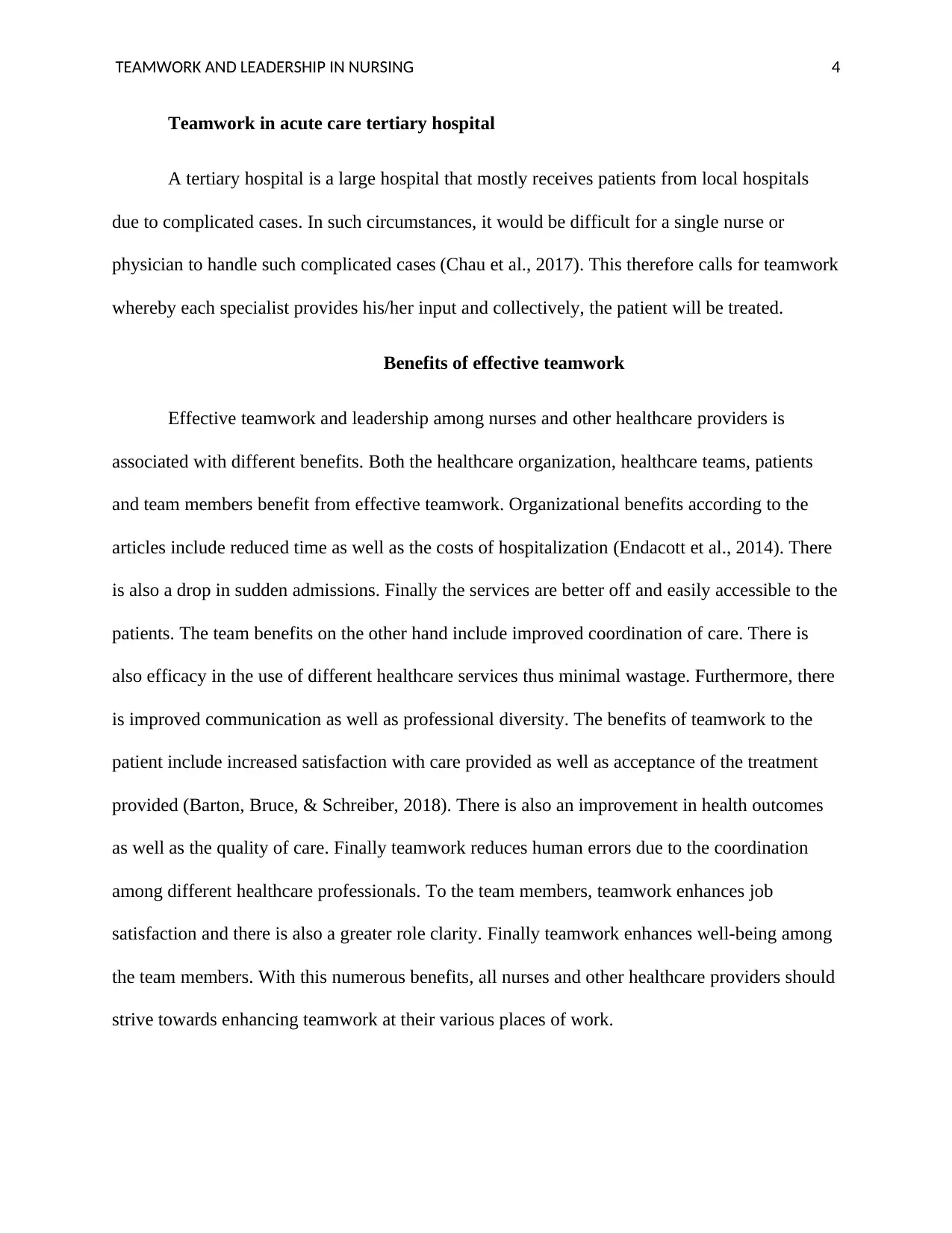
TEAMWORK AND LEADERSHIP IN NURSING 4
Teamwork in acute care tertiary hospital
A tertiary hospital is a large hospital that mostly receives patients from local hospitals
due to complicated cases. In such circumstances, it would be difficult for a single nurse or
physician to handle such complicated cases (Chau et al., 2017). This therefore calls for teamwork
whereby each specialist provides his/her input and collectively, the patient will be treated.
Benefits of effective teamwork
Effective teamwork and leadership among nurses and other healthcare providers is
associated with different benefits. Both the healthcare organization, healthcare teams, patients
and team members benefit from effective teamwork. Organizational benefits according to the
articles include reduced time as well as the costs of hospitalization (Endacott et al., 2014). There
is also a drop in sudden admissions. Finally the services are better off and easily accessible to the
patients. The team benefits on the other hand include improved coordination of care. There is
also efficacy in the use of different healthcare services thus minimal wastage. Furthermore, there
is improved communication as well as professional diversity. The benefits of teamwork to the
patient include increased satisfaction with care provided as well as acceptance of the treatment
provided (Barton, Bruce, & Schreiber, 2018). There is also an improvement in health outcomes
as well as the quality of care. Finally teamwork reduces human errors due to the coordination
among different healthcare professionals. To the team members, teamwork enhances job
satisfaction and there is also a greater role clarity. Finally teamwork enhances well-being among
the team members. With this numerous benefits, all nurses and other healthcare providers should
strive towards enhancing teamwork at their various places of work.
Teamwork in acute care tertiary hospital
A tertiary hospital is a large hospital that mostly receives patients from local hospitals
due to complicated cases. In such circumstances, it would be difficult for a single nurse or
physician to handle such complicated cases (Chau et al., 2017). This therefore calls for teamwork
whereby each specialist provides his/her input and collectively, the patient will be treated.
Benefits of effective teamwork
Effective teamwork and leadership among nurses and other healthcare providers is
associated with different benefits. Both the healthcare organization, healthcare teams, patients
and team members benefit from effective teamwork. Organizational benefits according to the
articles include reduced time as well as the costs of hospitalization (Endacott et al., 2014). There
is also a drop in sudden admissions. Finally the services are better off and easily accessible to the
patients. The team benefits on the other hand include improved coordination of care. There is
also efficacy in the use of different healthcare services thus minimal wastage. Furthermore, there
is improved communication as well as professional diversity. The benefits of teamwork to the
patient include increased satisfaction with care provided as well as acceptance of the treatment
provided (Barton, Bruce, & Schreiber, 2018). There is also an improvement in health outcomes
as well as the quality of care. Finally teamwork reduces human errors due to the coordination
among different healthcare professionals. To the team members, teamwork enhances job
satisfaction and there is also a greater role clarity. Finally teamwork enhances well-being among
the team members. With this numerous benefits, all nurses and other healthcare providers should
strive towards enhancing teamwork at their various places of work.
Paraphrase This Document
Need a fresh take? Get an instant paraphrase of this document with our AI Paraphraser
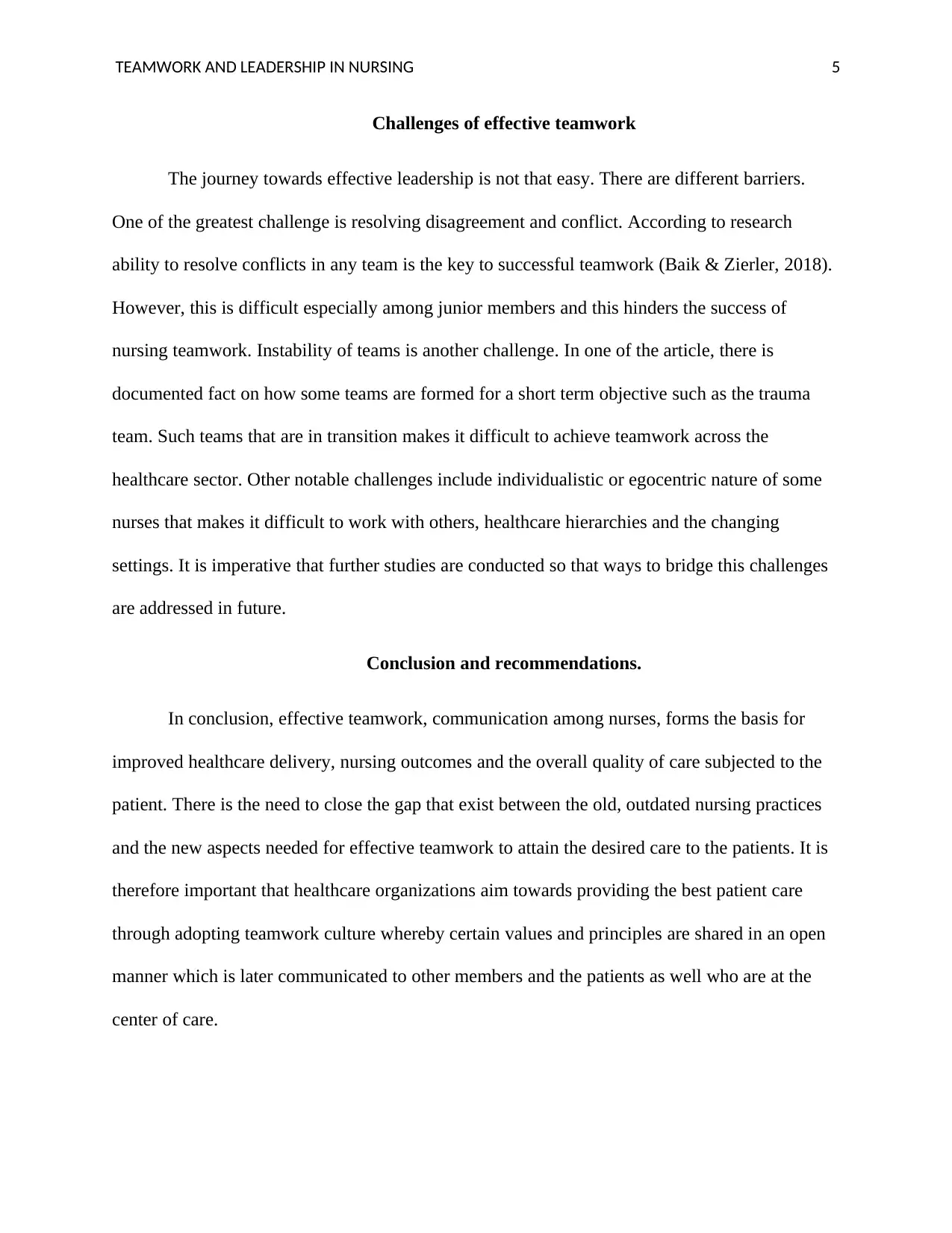
TEAMWORK AND LEADERSHIP IN NURSING 5
Challenges of effective teamwork
The journey towards effective leadership is not that easy. There are different barriers.
One of the greatest challenge is resolving disagreement and conflict. According to research
ability to resolve conflicts in any team is the key to successful teamwork (Baik & Zierler, 2018).
However, this is difficult especially among junior members and this hinders the success of
nursing teamwork. Instability of teams is another challenge. In one of the article, there is
documented fact on how some teams are formed for a short term objective such as the trauma
team. Such teams that are in transition makes it difficult to achieve teamwork across the
healthcare sector. Other notable challenges include individualistic or egocentric nature of some
nurses that makes it difficult to work with others, healthcare hierarchies and the changing
settings. It is imperative that further studies are conducted so that ways to bridge this challenges
are addressed in future.
Conclusion and recommendations.
In conclusion, effective teamwork, communication among nurses, forms the basis for
improved healthcare delivery, nursing outcomes and the overall quality of care subjected to the
patient. There is the need to close the gap that exist between the old, outdated nursing practices
and the new aspects needed for effective teamwork to attain the desired care to the patients. It is
therefore important that healthcare organizations aim towards providing the best patient care
through adopting teamwork culture whereby certain values and principles are shared in an open
manner which is later communicated to other members and the patients as well who are at the
center of care.
Challenges of effective teamwork
The journey towards effective leadership is not that easy. There are different barriers.
One of the greatest challenge is resolving disagreement and conflict. According to research
ability to resolve conflicts in any team is the key to successful teamwork (Baik & Zierler, 2018).
However, this is difficult especially among junior members and this hinders the success of
nursing teamwork. Instability of teams is another challenge. In one of the article, there is
documented fact on how some teams are formed for a short term objective such as the trauma
team. Such teams that are in transition makes it difficult to achieve teamwork across the
healthcare sector. Other notable challenges include individualistic or egocentric nature of some
nurses that makes it difficult to work with others, healthcare hierarchies and the changing
settings. It is imperative that further studies are conducted so that ways to bridge this challenges
are addressed in future.
Conclusion and recommendations.
In conclusion, effective teamwork, communication among nurses, forms the basis for
improved healthcare delivery, nursing outcomes and the overall quality of care subjected to the
patient. There is the need to close the gap that exist between the old, outdated nursing practices
and the new aspects needed for effective teamwork to attain the desired care to the patients. It is
therefore important that healthcare organizations aim towards providing the best patient care
through adopting teamwork culture whereby certain values and principles are shared in an open
manner which is later communicated to other members and the patients as well who are at the
center of care.
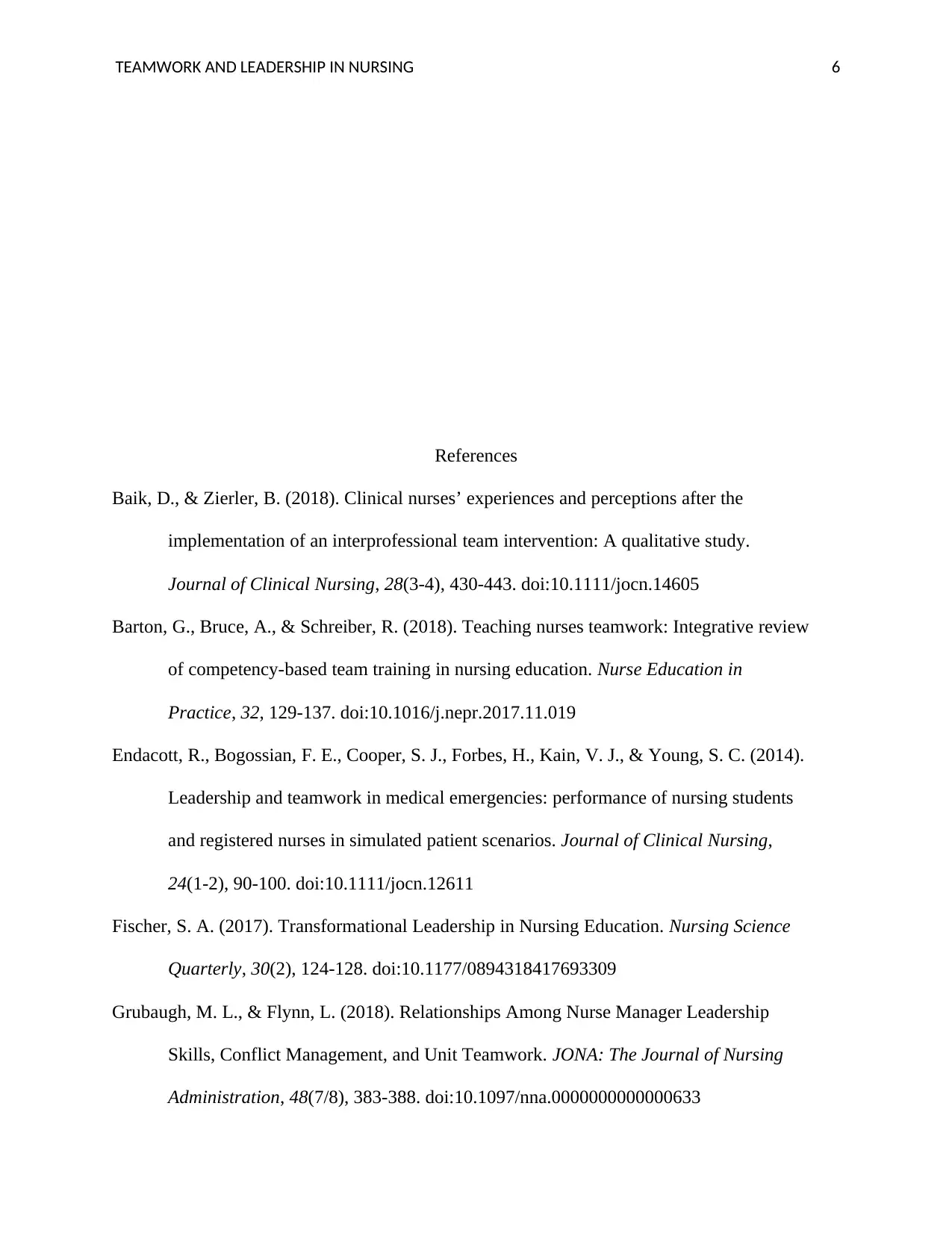
TEAMWORK AND LEADERSHIP IN NURSING 6
References
Baik, D., & Zierler, B. (2018). Clinical nurses’ experiences and perceptions after the
implementation of an interprofessional team intervention: A qualitative study.
Journal of Clinical Nursing, 28(3-4), 430-443. doi:10.1111/jocn.14605
Barton, G., Bruce, A., & Schreiber, R. (2018). Teaching nurses teamwork: Integrative review
of competency-based team training in nursing education. Nurse Education in
Practice, 32, 129-137. doi:10.1016/j.nepr.2017.11.019
Endacott, R., Bogossian, F. E., Cooper, S. J., Forbes, H., Kain, V. J., & Young, S. C. (2014).
Leadership and teamwork in medical emergencies: performance of nursing students
and registered nurses in simulated patient scenarios. Journal of Clinical Nursing,
24(1-2), 90-100. doi:10.1111/jocn.12611
Fischer, S. A. (2017). Transformational Leadership in Nursing Education. Nursing Science
Quarterly, 30(2), 124-128. doi:10.1177/0894318417693309
Grubaugh, M. L., & Flynn, L. (2018). Relationships Among Nurse Manager Leadership
Skills, Conflict Management, and Unit Teamwork. JONA: The Journal of Nursing
Administration, 48(7/8), 383-388. doi:10.1097/nna.0000000000000633
References
Baik, D., & Zierler, B. (2018). Clinical nurses’ experiences and perceptions after the
implementation of an interprofessional team intervention: A qualitative study.
Journal of Clinical Nursing, 28(3-4), 430-443. doi:10.1111/jocn.14605
Barton, G., Bruce, A., & Schreiber, R. (2018). Teaching nurses teamwork: Integrative review
of competency-based team training in nursing education. Nurse Education in
Practice, 32, 129-137. doi:10.1016/j.nepr.2017.11.019
Endacott, R., Bogossian, F. E., Cooper, S. J., Forbes, H., Kain, V. J., & Young, S. C. (2014).
Leadership and teamwork in medical emergencies: performance of nursing students
and registered nurses in simulated patient scenarios. Journal of Clinical Nursing,
24(1-2), 90-100. doi:10.1111/jocn.12611
Fischer, S. A. (2017). Transformational Leadership in Nursing Education. Nursing Science
Quarterly, 30(2), 124-128. doi:10.1177/0894318417693309
Grubaugh, M. L., & Flynn, L. (2018). Relationships Among Nurse Manager Leadership
Skills, Conflict Management, and Unit Teamwork. JONA: The Journal of Nursing
Administration, 48(7/8), 383-388. doi:10.1097/nna.0000000000000633
⊘ This is a preview!⊘
Do you want full access?
Subscribe today to unlock all pages.

Trusted by 1+ million students worldwide
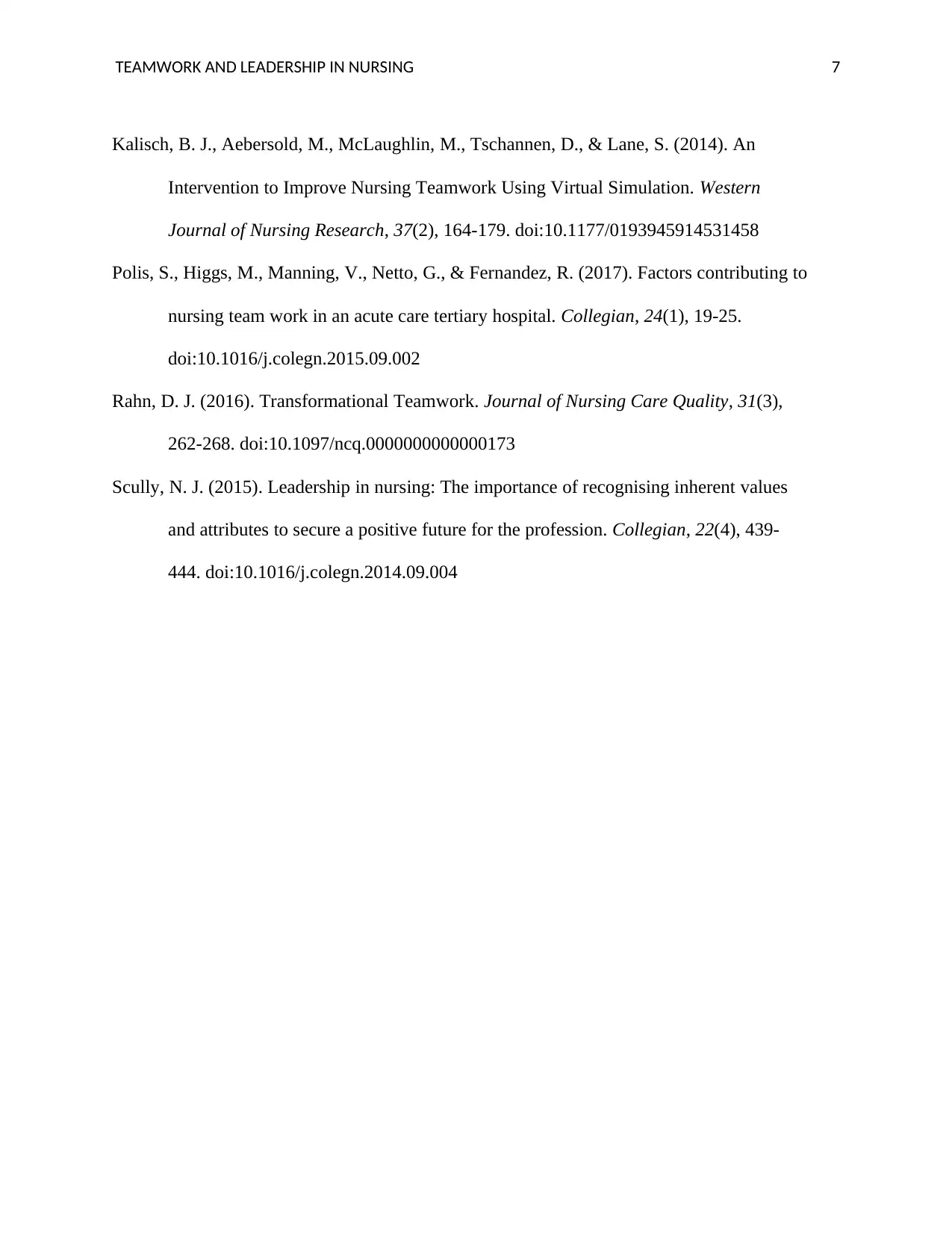
TEAMWORK AND LEADERSHIP IN NURSING 7
Kalisch, B. J., Aebersold, M., McLaughlin, M., Tschannen, D., & Lane, S. (2014). An
Intervention to Improve Nursing Teamwork Using Virtual Simulation. Western
Journal of Nursing Research, 37(2), 164-179. doi:10.1177/0193945914531458
Polis, S., Higgs, M., Manning, V., Netto, G., & Fernandez, R. (2017). Factors contributing to
nursing team work in an acute care tertiary hospital. Collegian, 24(1), 19-25.
doi:10.1016/j.colegn.2015.09.002
Rahn, D. J. (2016). Transformational Teamwork. Journal of Nursing Care Quality, 31(3),
262-268. doi:10.1097/ncq.0000000000000173
Scully, N. J. (2015). Leadership in nursing: The importance of recognising inherent values
and attributes to secure a positive future for the profession. Collegian, 22(4), 439-
444. doi:10.1016/j.colegn.2014.09.004
Kalisch, B. J., Aebersold, M., McLaughlin, M., Tschannen, D., & Lane, S. (2014). An
Intervention to Improve Nursing Teamwork Using Virtual Simulation. Western
Journal of Nursing Research, 37(2), 164-179. doi:10.1177/0193945914531458
Polis, S., Higgs, M., Manning, V., Netto, G., & Fernandez, R. (2017). Factors contributing to
nursing team work in an acute care tertiary hospital. Collegian, 24(1), 19-25.
doi:10.1016/j.colegn.2015.09.002
Rahn, D. J. (2016). Transformational Teamwork. Journal of Nursing Care Quality, 31(3),
262-268. doi:10.1097/ncq.0000000000000173
Scully, N. J. (2015). Leadership in nursing: The importance of recognising inherent values
and attributes to secure a positive future for the profession. Collegian, 22(4), 439-
444. doi:10.1016/j.colegn.2014.09.004
1 out of 7
Related Documents
Your All-in-One AI-Powered Toolkit for Academic Success.
+13062052269
info@desklib.com
Available 24*7 on WhatsApp / Email
![[object Object]](/_next/static/media/star-bottom.7253800d.svg)
Unlock your academic potential
Copyright © 2020–2025 A2Z Services. All Rights Reserved. Developed and managed by ZUCOL.





